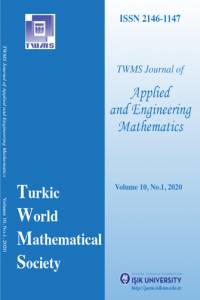INTUITIONISTIC FUZZY BI-IMPLICATOR AND PROPERTIES OF LUKASIEWICZ INTUITIONISTIC FUZZY BI-IMPLICATOR
Intuitionistic fuzzy set Intuitionistic fuzzy implicator, Intuitionistic fuzzy t-norm, Intuitionistic fuzzy bi-implicator.,
___
- [1] Atanassov, K. T. (1986). Intuitionistic fuzzy sets. Fuzzy sets and Systems, 20(1), 87-96.
- [2] Atanassov, K. T. (1999). Applications of Intuitionistic Fuzzy Sets. In Intuitionistic Fuzzy Sets Physica-Verlag HD, 237-288.
- [3] Atanassov, K. T. (2001). Remarks on the conjunctions, disjunctions and implications of the intuitionistic fuzzy logic. International Journal of Uncertainty, Fuzziness and Knowledge-Based Systems, 9(01), 55-65.
- [4] Ashraf, S., Kerre, E.E., & Qayyum, M. (2017). The intuitionistic fuzzy multicriteria decision making based on inclusion degree. Comptes Rendus Del’ Academie Bulgare Des Sciences, 70(7), 925-934.
- [5] Baczynski, M. (2003). On some properties of intuitionistic fuzzy implications. In EUSFLAT Conf, 168-171.
- [6] Bedregal, B. C. and Cruz, A. P. (2008). A characterization of classic-like fuzzy semantics. Logic Journal of IGPL, 16(4), 357-370.
- [7] Bustince, H., and Burillo, P. (1996). Vague sets are intuitionistic fuzzy sets. Fuzzy Sets and Systems, 79(3), 403-405.
- [8] Bustince, H., Barrenechea, E. and Pagola, M. (2006). Restricted equivalence functions. Fuzzy Sets and Systems, 157(17), 2333-2346.
- [9] Cornelis, C., Deschrijver, G. and Kerre, E. (2004). Implication in Intuitionistic fuzzy and interval-valued fuzzy set theory: construction, classification, application. International Journal of Approximate Reasoning, 35(1), 55-95.
- [10] Cornelis, C., Deschrijver, G. and Kerre, E. (2002). Classification Of Intuitionistic Fuzzy Implicators: An Algebraic Approach. In JCIS,105-108.
- [11] Deschrijver, G. and Kerre, E. (2003). On the relationship between some extensions of fuzzy set theory. Fuzzy sets and systems, 133(2), 227-235.
- [12] Deschrijver, G., Cornelis, C. and Kerre, E. (2004). On the representation of intuitionistic fuzzy t-norms and t-conorms. Fuzzy Systems, IEEE Transactions on, 12(1), 45-61.
- [13] Deschrijver, G. and Kerre, E. (2003). Classes of intuitionistic fuzzy t-norms satisfying the residuation principle. International Journal of Uncertainty, Fuzziness and Knowledge-Based Systems, 11(06), 691-709.
- [14] Fodor, J. C. and Roubens, M. R. (2013). Fuzzy preference modelling and multicriteria decision support. Springer Science & Business Media 14(1).
- [15] Gau, W. L., and Buehrer, D. J. (1993). Vague sets. IEEE Transactions on Systems, Man, and Cybernetics, 23(2), 610-614.
- [16] H´ajek, P. (1998). Metamathematics of fuzzy logic. Springer Science & Business Media, 4(1).
- [17] Moser, B. (2006). On the T-transitivity of kernels. Fuzzy Sets and Systems, 157(13), 1787-1796.
- [18] Murugadas, P., and Lalitha, K. (2014). Bi-implication Operator on Intuitionistic Fuzzy Set. International Journal of Computer Applications, 89(1).
- [19] Nov´ak, V. and De Baets, B. (2009). EQ-algebras. Fuzzy Sets and Systems, 160(20), 2956-2978.
- 20] Qayyum, M., S. Ashraf, E. E. Kerre (2016). Measure of intuitionistic fuzzy inclusion. Comptes Rendus Del’ Academie Bulgare Des Sciences, 69(8), 971-980.
- ISSN: 2146-1147
- Başlangıç: 2010
- Yayıncı: Turkic World Mathematical Society
Sr. I. K. MUDARTHA, R. SUNDARESWARAN, V. SWAMİNATHAN
T. M. ALİEV, E. A. IBAYEV, V. M. MAMEDOV
S. ASHRAF, M. QAYYUM, E. E. KERR
